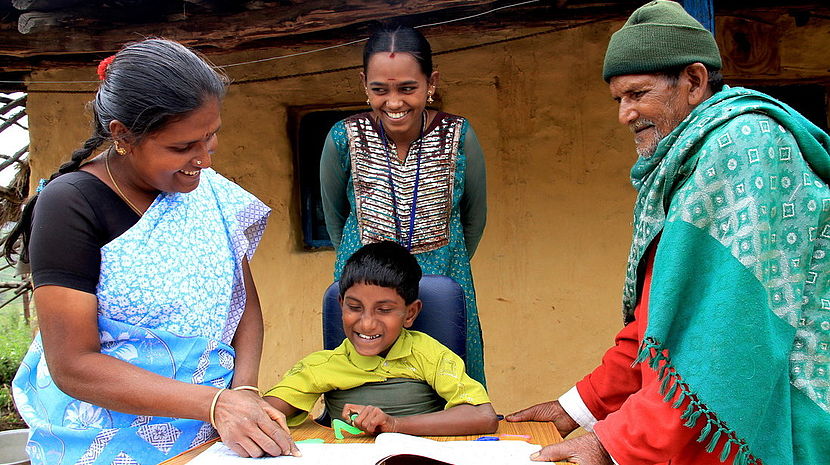Leading change with local partners in Bangladesh

In this article we highlight our partner 'Centre for Disability in Development' in Bangladesh who focusses on developing capacity building resources and building the leadership qualities of people with disabilities.
Disability in Bangladesh
It is estimated that some 16 million people are living with a disability in Bangladesh [1]. With little awareness of disability throughout the country, especially in rural areas, the effects upon quality of life are marked. Studies show disability negatively impacts marriages, and the ability to gain an education and employment [2], which are crucial in the fight against poverty.
CDD’s approach to disability inclusive development
The Centre for Disability in Development (CDD) established the Promotion of Human Rights of Persons with Disabilities in Bangladesh project to develop capacity building resources and build the leadership qualities of people with disabilities. The project seeks to ensure people with disabilities not only participate in but also lead development initiatives.
The project is implemented in partnership with twelve partner organisations (four DPOs or organisations led by people with disabilities and eight mainstream development NGOs) located in ten districts. CDD undertake the majority of training, resource development, national level advocacy and lobbying in Dhaka.
Partners focus on working at the local community level to help determine the needs and priorities of people with disabilities and what type of capacity building is needed to empower people with disabilities to become leaders.
The project also focuses on therapeutic rehabilitation, referrals and provision of assistive devices to increase the functional capacity and mobility range of people with disabilities. All of these activities are developed to support the inclusion of people with disabilities and empower them to act as leaders and rights agents.
How is the project implemented?
In each new area, CDD spends time listening to the experiences of local people with disabilities, their families and any local organisations that work with people with disabilities.
This learning is used to help plan the project. In each area, CDD seeks to partner with a local organisation that has undergone some prior disability inclusion training with CDD.
Once selected as a partner, the local organisation then receives additional training about disability rights and inclusion, action planning, advocacy and campaigning, gender and child protection. Each partner is supported to employ two full time staff members (which must include a woman and a person with a disability), to fulfil the roles of a community disability rehabilitation officer and a community mobiliser.
The partner is asked to identify and invite people with disabilities from their local community to attend a day leadership training. This training is run by CDD in Dhaka and aims to build the capacity of people with disabilities to become leaders and advocate for their rights. The local partner assists the participants to travel to Dhaka to attend the training program, and then works with them upon their return to establish self help groups of people with disabilities and educate the community about disability inclusion.
CDD oversees advocacy activities at the local, district and national levels. They identify the key issues for people with disabilities through discussions with partners, self help groups and apex bodies, and work with partners to organise advocacy events with speakers who have a disability.
Progress towards inclusion
- Self help group members now meet with local government representatives and interact with other community members
- Local governments have increased the budget allocated to schemes for people with disabilities.
- Self help group meetings are now held in government offices
- Some self help groups have started to see encouraging changes in the attitudes of government with the construction of public housing for people with disabilities
- Following advocacy efforts, five acres of government land was allotted to one self help group. The group has used the land to cultivate vegetables and shares the profits among the group
- Project staff have noticed a significant change in the confidence of people with disabilities. People with disabilities are standing up for themselves and fighting for their rights to be upheld. Community members call people with disabilities by their names instead of taunting them with offensive names.
What is most effective?
Instead of directly implementing projects, CDD builds the capacity of existing organisations to support people with disabilities. By acting as a facilitator, CDD leverages their strong relationships with partner organisations and communities to create lasting change where disability inclusion becomes a priority for all development efforts. This approach is effective because it utilises the credibility local organisations have within their communities while providing much needed on the ground support to people with disabilities. It also means CDD can focus on training more organisations to become disability inclusive as their energy is spent on capacity building rather than project implementation.
By overseeing and guiding partners and organisations instead of directly implementing projects, CDD is able to invest time in developing the specific resources required for disability inclusion that can be used consistently across training programs and for national level advocacy and lobbying. These resources are used by the self managed self help groups to ensure they have the right support to lead their own initiatives and continue to be run by the people they exist to support. This ‘hands off’ approach is effective in building leadership skills, empowering people with disabilities to advocate for their own rights collectively. Importantly, it gives the group members a strong sense of control and ownership over the direction of their activities.
Notes:
[1] www.cdd.org.bd
[2] Mitra, Sophie, Posarac, Aleksandra & Vick, Brandon C, ‘Disability and poverty in developing countries: A snapshot from the World Health Survey’ (April 2011). World Bank Social Protection Working Paper No. 1109.